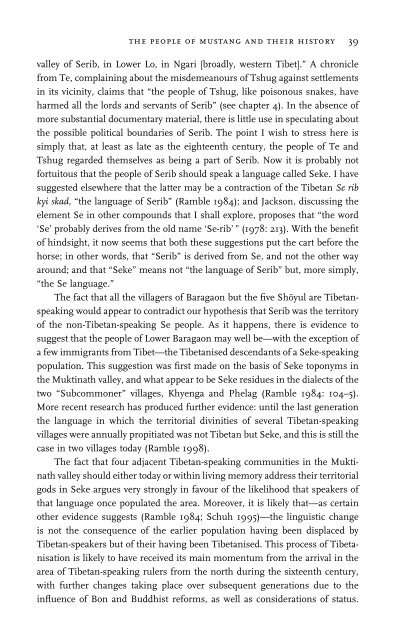Navel of the Demoness : Tibetan Buddhism and Civil Religion in ...
Navel of the Demoness : Tibetan Buddhism and Civil Religion in ...
Navel of the Demoness : Tibetan Buddhism and Civil Religion in ...
You also want an ePaper? Increase the reach of your titles
YUMPU automatically turns print PDFs into web optimized ePapers that Google loves.
14 <strong>the</strong>navel<strong>of</strong><strong>the</strong>demoness<br />
Thrower goes so far as to propose a direct historical l<strong>in</strong>k between <strong>the</strong> civil<br />
religion <strong>of</strong> ancient Rome <strong>and</strong> that <strong>of</strong> <strong>the</strong> Soviet Union, ‘‘mediated to Russia<br />
from Byzantium <strong>and</strong> ...passed on to <strong>the</strong> new Communist rulers <strong>of</strong> Russia <strong>and</strong><br />
her Empire’’ (1992: 145).<br />
Much as <strong>in</strong> <strong>the</strong> case <strong>of</strong> France immediately after her own revolution,<br />
Russia <strong>in</strong> 1917 saw a proliferation <strong>of</strong> secular rites—‘‘Bolshevik ceremonies’’—<br />
that were fabricated as substitutes for <strong>the</strong> discredited Orthodox rituals: an<br />
Octobrist ceremony to celebrate childbirth, ‘‘red wedd<strong>in</strong>gs,’’ ‘‘red funerals,’’ <strong>and</strong><br />
so forth. However, it was only <strong>in</strong> <strong>the</strong> decade follow<strong>in</strong>g <strong>the</strong> death <strong>of</strong> Len<strong>in</strong> <strong>in</strong><br />
1924 that Marxism-Len<strong>in</strong>ism began to take on <strong>the</strong> characteristics <strong>of</strong> a civil religion;<br />
it became <strong>the</strong> ‘‘transcendental reference’’ <strong>in</strong> <strong>the</strong> background <strong>of</strong> all Soviet<br />
Russia. ‘‘The first step <strong>in</strong> this process was taken when <strong>the</strong> Communist Party,<br />
<strong>the</strong> Government <strong>and</strong> <strong>the</strong> State became an <strong>in</strong>terlock<strong>in</strong>g, s<strong>in</strong>gle monolithic <strong>in</strong>stitution—an<br />
<strong>in</strong>stitution that from this period until his death <strong>in</strong> 1953, was both<br />
symbolically <strong>and</strong> effectively, Stal<strong>in</strong> himself ’’ (Thrower 1992: 164). To this extent,<br />
Thrower suggests, Stal<strong>in</strong>’s position was analogous to that <strong>of</strong> Augustus <strong>in</strong><br />
later Roman civil religion.<br />
The importance <strong>of</strong> a canon <strong>in</strong> <strong>the</strong> constitution <strong>of</strong> any religion—civil or<br />
o<strong>the</strong>rwise—will be discussed <strong>in</strong> chapter 9 (where <strong>the</strong> concept <strong>of</strong> transcendence,<br />
<strong>in</strong>voked above, will also be considered). Soviet civil religion, Thrower<br />
ma<strong>in</strong>ta<strong>in</strong>s, was no exception: <strong>the</strong> canon was <strong>the</strong> only permitted <strong>in</strong>terpretation<br />
<strong>of</strong> Marxism-Len<strong>in</strong>ism—Stal<strong>in</strong>’s own A History <strong>of</strong> <strong>the</strong> Communist Party <strong>of</strong> <strong>the</strong><br />
Soviet Union (Bolsheviks): A Short Course (1938). The real purpose <strong>of</strong> <strong>the</strong> Short<br />
Course was not history but myth: it was <strong>in</strong>tended to legitimise <strong>the</strong> Soviet state<br />
<strong>and</strong> <strong>the</strong> Communist Party’s role <strong>in</strong> it. Marxism-Len<strong>in</strong>ism was ‘‘a civil religion<br />
whose primary purpose, like that <strong>of</strong> <strong>the</strong> great state civil religions <strong>of</strong> antiquity,<br />
was to legitimate <strong>the</strong> exist<strong>in</strong>g order <strong>of</strong> society, keep chaos at bay, <strong>and</strong> to purvey<br />
a sense <strong>of</strong> historic mission’’ (Thrower 1992: 168).<br />
Accord<strong>in</strong>g to Liebman <strong>and</strong> Don-Yehiya, it is precisely <strong>the</strong> fact that it is<br />
elaborated around a social agenda that dist<strong>in</strong>guishes Israel’s civil religion from<br />
Judaism. The former may look very similar to traditional religion (<strong>the</strong> authors’<br />
term), ‘‘but at its core st<strong>and</strong>s a corporate entity ra<strong>the</strong>r than a transcendent<br />
power, even if it also refers to a transcendent reality or even a supernatural<br />
power’’ (Liebman <strong>and</strong> Don-Yehiya 1983: 4). What gives traditional religion its<br />
superiority is <strong>the</strong> centrality <strong>of</strong> God <strong>and</strong> <strong>the</strong> concomitant possibility <strong>of</strong> a private<br />
soteriology. The transfer <strong>of</strong> supreme authority from God to society means that<br />
civil religion ‘‘can nei<strong>the</strong>r provide <strong>the</strong> <strong>in</strong>dividual with ultimate mean<strong>in</strong>g nor<br />
evoke from him <strong>the</strong> <strong>in</strong>tensity <strong>of</strong> commitment which traditional religion can.’’<br />
The ‘‘objective’’ <strong>of</strong> civil religion, that is, ‘‘<strong>the</strong> sanctification <strong>of</strong> <strong>the</strong> society <strong>in</strong>


